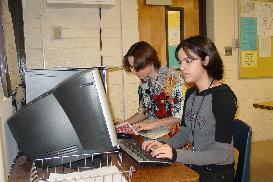
Tuesday May 18, 2010
WiS Lesson 10A
The original Writing in Stereo was published online back in the late 1980's. Its purpose was to apply creative radio dramatics or broadcast journalism to all aspects of the teaching of high school English. Each lesson included a lesson plan and notes. I'm sharing these with you here. UNIT OBJECTIVE: (X) The student will improve skills in expository writing by composing and recording the instructional program.
LESSON OBJECTIVE: (A) The student will generate a list of skills completing the phrase: "How to ..." and select one for the subject of an instructional program.
MATERIALS REQUIRED: Paper and pencil
INTRODUCTION: We're going to write and record instructional--that's the "how-to"--program. First we have to decide what you know how to do.
PROCEDURE
1. Ask students to make a list of the many things they feel competent to do ... a dozen things that complete the phrase, "how to ...".
2. Have them select the five competencies they feel would make good radio instructional subjects. (Before selecting from those five the one for scripting, remind them this must be explained without benefit of visuals.)
3. After each has selected the competency to be shared, impress upon students that the how-to phrase must now disappear from the opening sentence of their script. As has been the case with all previous news stories and features, their script should begin with a soft lede.
4. Complete the soft lede paragraph for the program.
EVALUATION FOCUS: Look for that successful transition from "How to change a tire" to: "You're crossing the desert on the interstate. The unthinkable happens. A blow-out. It doesn't have to be a disaster."
Notes (X.A)
The example in the Evaluation Focus is typical of a problem ... a little one ... you'll probably deal with. For some reason my students need to be reminded an essay (or paragraph) may not begin, "How to (bake a cake, change a tire, make a dress, tune up your engine, get an A in a class, etc.)". That "how-to" must become a soft lede. The example of the soft lede written for changing a tire demonstrates the paradox of usage in radio. Although we do not begin with the "how-to," we may find "incomplete" sentences in the first paragraph. Those fragments are typical of the conversational style of radio.
One can create ledes the same way for any of the "How-to's" suggested above.
"Your little brother's birthday party can be good news. You can show off a little. Try baking the cake. It's easy. And you'll discover a terrific way to express yourself."
"So you're in trouble again. You're getting a D in
chemistry. Your dad's going to kill you. Wise up! Getting A's is not that difficult."
(Notice we've dropped the objectivity used in the news pieces. Now we're talking directly to the listener.)
UNIT OBJECTIVE: (X) The student will improve skills in expository writing by composing and recording the instructional program.
LESSON OBJECTIVE: (A) The student will generate a list of skills completing the phrase: "How to ..." and select one for the subject of an instructional program.
MATERIALS REQUIRED: Paper and pencil
INTRODUCTION: We're going to write and record instructional--that's the "how-to"--program. First we have to decide what you know how to do.
PROCEDURE
1. Ask students to make a list of the many things they feel competent to do ... a dozen things that complete the phrase, "how to ...".
2. Have them select the five competencies they feel would make good radio instructional subjects. (Before selecting from those five the one for scripting, remind them this must be explained without benefit of visuals.)
3. After each has selected the competency to be shared, impress upon students that the how-to phrase must now disappear from the opening sentence of their script. As has been the case with all previous news stories and features, their script should begin with a soft lede.
4. Complete the soft lede paragraph for the program.
EVALUATION FOCUS: Look for that successful transition from "How to change a tire" to: "You're crossing the desert on the interstate. The unthinkable happens. A blow-out. It doesn't have to be a disaster."
Notes (X.A)
The example in the Evaluation Focus is typical of a problem ... a little one ... you'll probably deal with. For some reason my students need to be reminded an essay (or paragraph) may not begin, "How to (bake a cake, change a tire, make a dress, tune up your engine, get an A in a class, etc.)". That "how-to" must become a soft lede. The example of the soft lede written for changing a tire demonstrates the paradox of usage in radio. Although we do not begin with the "how-to," we may find "incomplete" sentences in the first paragraph. Those fragments are typical of the conversational style of radio.
One can create ledes the same way for any of the "How-to's" suggested above.
"Your little brother's birthday party can be good news. You can show off a little. Try baking the cake. It's easy. And you'll discover a terrific way to express yourself."
"So you're in trouble again. You're getting a D in
chemistry. Your dad's going to kill you. Wise up! Getting A's is not that difficult."
(Notice we've dropped the objectivity used in the news pieces. Now we're talking directly to the listener.)
No comments yet. Be the first to say something!